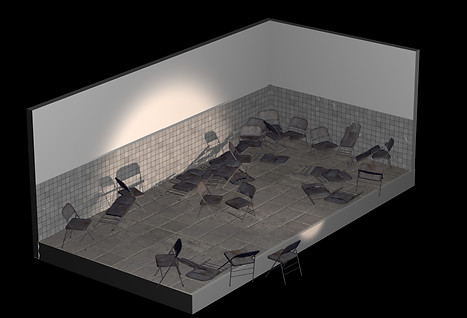
![wyh [已恢复]-05.png](https://static.wixstatic.com/media/0e1f86_b627d9e455f54d4eb4f18e8c28c78b76~mv2.png/v1/crop/x_912,y_0,w_4093,h_1645/fill/w_776,h_312,al_c,q_85,usm_0.66_1.00_0.01,enc_avif,quality_auto/wyh%20%5B%E5%B7%B2%E6%81%A2%E5%A4%8D%5D-05.png)
What if everyone can dance?
What if everyone can have their own dance partner?
What if dance can change
how people interact and perceive in environments?
Overview
Since 2017, I have dedicated significant time to dancing. Dance is more than just a collection of body movements—it is an abstract expression of spatial relationships between individuals and their environment. It encompasses both personal space occupation and dynamic interactions between individuals. By training a model based on Latin dance choreography, I aim to explore how these spatial relationships can inform non-dancers’ interactions with their surroundings and influence the way they engage with others.
Graduation Design Project at Tsinghua University
Instructor : Fan Xiang
2020 - Nov 2021
Awards:
-Graduate 360° -100 graduation works of the year
-Specifific prize of Data Visualization, 2021‘think youth’ -Shanghai International Digital Creation, Innovation& Entrepreneurship Competition
-2021 Young Battle :Nominated Best Graduation Project
Key Paradigm
Latin dance Motion
Machine learning
Interactive media
Data source
ML Modeling
Visualization
The Boundless Dance project integrates Latin dance motion as a data source, uses machine learning to model spatial dynamics, and employs interactive media for visualization. This paradigm bridges art and technology to explore and enhance spatial relationships.
In my dance experience,
I’ve realized that dance performances are often one-way communication, flowing from the dancer to the audience, with little opportunity for the audience to engage or immerse themselves in the art of dance.
Can we make everyone dance?
Approach
By collecting and training motion data from dance, I created an interactive dance system that prioritizes non-dancer audiences, allowing them to take an active role in the interaction and engage directly with the art of dance.

Paradigm


Data collection
For data collection, I utilized optical motion capture to record the dynamic positional data of GBD, covering three Latin dance styles: rumba, samba, and cha-cha. This resulted in a comprehensive dataset encompassing a wide range of dance movements, body relationships, and fundamental rhythmic dynamics in GBD Latin dance.
Through this process, I discovered that the essence of dance interaction lies in the collision and compression of individual spatial relationships.





Model Training
For model training, my goal was to enable users to become the "dancer" in the interaction, with the media providing real-time movement feedback, much like a virtual dance partner. For instance, if a user walks forward and raises their right hand, the virtual partner would respond accordingly in a contextually relevant manner.
Since non-dancer users exhibit random movements, the model couldn’t rely on standard dance movements as a reference. Instead, I decomposed each user’s body movement data for detailed analysis. Using machine learning, I trained the dataset to model the relationship between spatial positions and body movements among dancers, allowing the system to interpret and respond dynamically.

Visualization
The next challenge was visualizing the dance partner. Inspired by reference projects, I questioned whether the visualization of dance data needed to be restricted to a human character. This led me to experiment with binding the body points from the trained model to various visual objects.
By detaching from the traditional "human" figure, non-dancer users were able to interact more freely, without being constrained by the visual aesthetics of the human body. In doing so, I expanded the concept of "dance," transforming it into a broader, more inclusive form of expression.



I turned my attention to everyday objects, searching for something with both symbolic meaning and a high degree of movability.
Chairs stood out as a fitting choice due to their resemblance to humans and their inherent sense of humor. Typically seen as static, straight, and ordinary, chairs contrast sharply with the fluid and expressive nature of dance. This contrast creates a subtle, yet impactful, effect when a chair "dances."
The design conveys a message to the audience: "You may see yourself as an ordinary, static chair incapable of dancing, but this work proves that even you can dance."












Interactive Media
I used the Kinect to capture users' body movements in real time, enabling these movements to interact dynamically with the media—the virtual dance partner. Through this system, users became one of the "chairs" in the media, actively engaging in the dance experience.



